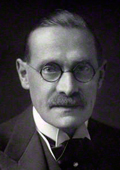 |
George Herbert Hyde Villiers
b. 7 Jun 1877, London, England, U.K.
d. 13 Dec 1955, London, England, U.K. |
| Title: |
Governor-General and Commander-in-Chief in and over the Union of South Africa ::
Goewerneur-generaal en Opperbevelhebber in en oor die Unie van Suid-Afrika |
| Term: |
26 Jan 1931 - 5 Apr 1937 |
| Chronology: |
3 Dec 1930,
appointed by Commission under the Royal Sign Manual and Signet [1] |
| |
26 Jan 1931, took an oath of allegiance and an oath of office as Governor-General and Commander-in-Chief of the Union of South Africa, Government House, Cape Town [2] |
| |
5 Apr 1937,
appointment superseded by the Commission of a successor effective on a prescibed date (5 Apr 1937) [3][4] |
| Names/titles: |
Nobility title (by courtesy): Lord Hyde (1877-1914); nobility titles (succession): Earl of Clarendon, Baron Hyde, of Hindon, in the county of Wilts (from 2 Oct 1914) |
| Biography: |
| The only son of Edward Hyde Villiers, 5th Earl of Clarendon; was educated at Misbourne House School and Eton College (1891-1893); was named extra aide-de-camp to the Lord-Lieutenant of Ireland (1902-1905); gained the rank of Honorary Lieutenant-Colonel in the Army; succeeded his father as the 6th Earl of Clarendon in 1914 and took a seat in the House of Lords; Chancellor and Treasurer of the Primrose League (1919-1921); served as the first chairman of British Broadcasting Corporation (1920-1930); served as Lord-in-Waiting to King George V (1921-1922); appointed Captain of the Body Guards of the Honourable Corps of Gentlemen at Arms (1922-1924, 1924-1925); held the office of Chief Whip (Conservative) of the House of Lords (1922-1925); appointed Parliamentary Under-Secretary of State of Dominion Affairs and Chairman of the Oversea Settlement Committee (1925-1926); Justice of the Peace and Deputy Lieutenant for Hertfordshire; held the posts of director of the English Insurance Company and General Electric Company; appointed Governor-General and Commander-in-Chief of the Union of South Africa (1931-1937); was the first governor-general to serve solely as the representative of the Crown and the last Englishman to hold the post; sworn in as a member of the U.K. Privy Council 8 Aug 1933 (appointed 20 Mar 1931); appointed (1 Jul 1938) and sworn in (13 Jul 1938) as Lord Chamberlain of the Household (1 Jul 1938 - 20 Oct 1952). |
| Biographical sources: "Encyclopaedia of Southern Africa", ed. by Eric Rosenthal (London and New York: Frederick Warne & Co., 1973), 1:114; The Times, No. 53,403, Royal Edition, 14 Dec 1955, pp. 1, 11 (obituary) |
| |
| [1] |
Government Gazette, No. 1921, Extra, 26 Jan 1931, p. ii. |
| [2] |
Government Gazette, No. 1921, Extra, 26 Jan 1931, p. (i). |
| [3] |
Government Gazette, No. 2427, Extra, 5 Apr 1937, p. 2. |
| [4] |
After the Earl of Clarendon permanently left South Africa, his functions were taken over by John Stephen Curlewis as Officer Administering the Government of the Union of South Africa :: Amptenaar Belas met die Uitoefening van die Uitvoerende Gesag van die Unie van Suid-Afrika (19 Mar 1937 - 5 Apr 1937) who continued in office until the installation of Sir Patrick Duncan. |
| |
Image: photograph (1930) |